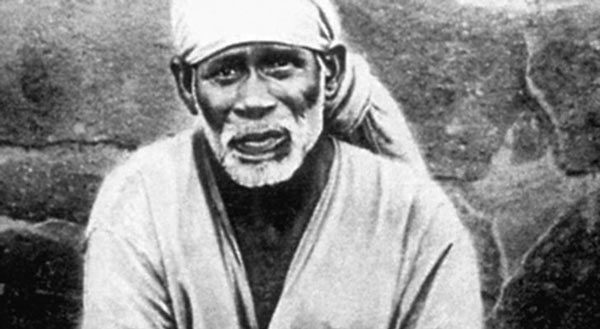The young man was an odd sight when he first appeared under the neem tree. The place and time: Shirdi, a tiny village in India, mid-1800s. Clad in rags, he sat in meditation for hours, oblivious to the world around him. The village children thought he was crazy, and they threw stones at him. But some of the wiser villagers recognized the signs of an emerging saint. Such intense sadhana, spiritual practice, is the sign of a pure soul.
The village people were accustomed to traveling mendicants. They weren’t concerned when he occasionally disappeared. But when he returned in 1858 he never left again. The village was changed forever.
For the first few years, the sage kept to himself. He continued long hours of meditation and was gradually accepted by the villagers. Eventually, he became a respected treasure of the town. He is known as Sai Baba of Shirdi still today.
The Uniqueness of Sai Baba
Most saints are unusual or unique in some way. Sai Baba was no exception. He was native to the Indian state of Maharashtra, an area that produced many saints. But he was unlike any of those who came before him.
There’s no conclusive record of Sai Baba’s birth place or year. His childhood and education are a mystery. Even the name given to him by his parents is unknown. Sai Baba, a name conferred by one of his earliest followers, denotes extreme respect for an older, wiser man.
Maharashtran saints who preceded Sai Baba, like Jñāneshvar and Nāmdev were born into the Hindu religion. But Sai Baba made no claim to a religious background. When questioned by villagers and followers about his past, Sai Baba insisted that it was of no account. He wore the distinct Sufi garb of a cap and long robe which further confused people about his heritage.
Claimed by Hindus and Muslims
Both Hindus and Muslims wished to claim Sai Baba as their own. He was, after all, well versed in each of their scriptures and traditions. But Sai Baba refused to be identified with anything but the doctrine of the unity of all creation.
Sai Baba didn’t initiate a new sect, nor did he author any texts. He endorsed the teachings of all religions, especially Hinduism and Islam, the prevailing beliefs of the area. Sai Baba easily interpreted and explained scriptures from both faiths. And he insisted that people remain devoted to their own religions.
Sai Baba opposed religious intolerance. When people came to him for advice, he encouraged them to love everyone equally. He taught compassion and patience. Sai Baba instructed his followers to help others willingly and generously.
“If any men or creatures come to you, do not discourteously drive them away, but receive them well and treat them with due respect. (God) will be certainly pleased if you give water to the thirsty, bread to the hungry, clothes to the naked and your verandah to strangers for sitting and resting. If anybody wants any money from you and you are not inclined to give, do not give, but do not bark at him like a dog.”
The Central Teaching of Sai Baba
Some people are drawn to saints hoping for material gain. Others are enthralled by the miracles that seem to surround them. Those who approach a saint with a pure mind and seek spiritual enlightenment receive the most. Sai Baba said, “I give people what they want, in the hope that they will begin to want what I want to give them.” He knew that worldly desires are very enticing.
Everyone received blessings from Sai Baba. He taught patience and tolerance by his own example. Unity, blessedness, and respect for all life was a central theme in Sai Baba’s teachings.
As a true saint, Sai Baba had realized his own identity with the Divine. This was his central teaching:
“God is, and there is nothing higher than Him. He is perfect, infinite and eternal. He is omnipresent, omnipotent and omniscient. He is the Creator, Sustainer, and Destroyer. Surrender voluntarily and totally to His will. Not a blade of grass moves without His will. Trust in Him and do the right. Let the inner light of Consciousness guide all your actions.”
Sai Baba’s Influence Continues Today
And, as a true Guru, Sai Baba emphasized the identity of God, Guru, and one’s own inner Self. He often reminded devotees of his presence in their own hearts. He offered them comfort in the present and future.
“Though I am here, and you are beyond the seven seas,
Whatever you do there, I come to know at once.
Wherever you go, I am always with you;
I dwell in your heart, I am within you.
Bow always to me who am in your heart.
Know that I also dwell in the hearts of all creatures—
Whether at your home, doorstep or on the way.
Whether it is an insect, an ant, a fish or a bird,
An animal, a dog or a pig,
In all these I abide forever
And I pervade everything.
Do not regard yourself as separate from me;
We are one.
Blessed is he who realizes this Truth.”
Sai Baba left his body one hundred years ago, but devotees continue to increase in number. They are still attracted by his compassion, love, and message of tolerance. Thousands of devotees visit Shirdi daily, where the once tiny village has expanded into a major place of pilgrimage.
Chityānanda has been a disciple of Svāmī Gurupremānanda Sarasvatī since 1975. She teaches meditation and yoga as a spiritual path in Santa Cruz, California.



Like all your articles this one in particular draws you in and makes you want more. Excellent topic and writing. I can’t wait to buy the book about his lovely saint.
Thank you for your nice comment, Nakisa. I know that you’ll enjoy the book! Namaste.
Hi, “Nothing exempts you from hard work.” The Daily Stoic newsletter reminded me that even Sai Baba worked. He kept a lantern lit at all times and would go out begging for oil. Usually several shopkeepers provided it while villagers gave for his other needs.
Thank you, Tony. It’s a very good comment: Nothing exempts you from hard work. So many people expect so much from so little these days. If saints had to work, then surely we do, too. Namaste.
What a good introduction to Sai Baba of Shirdi. Please post this entire article for our calendar saints this month.
Thank you, SG. I will do it. Namaste.
What a nice reminder about the universality of saints’ attainments.
Just yesterday a Baha’i adherent, asked me if the yoga I practice is “Hindu”? After I assured him, “No,” he asked: “Well, your guru is probably a Hindu, yes?” He was amazed to hear my Guru was born into the Zoroastrian faith instead.
In the end, we both agreed all the world’s great religions actually revolve around shared principles of love, compassion, and selfless service.
Thank you, Swami C. ?
Thank you for sharing your experience, Rob. I find that it’s a very common misconception: yoga = Hinduism. I try to point that out from time to time on Quiet Karma. I’ve always appreciated the open mindedness of Baha’i practitioners. They’re some of my favorite people. Namaste.
–He taught patience and tolerance by his own example.– Dear Svami, I needed to hear this today.
This section as well is very moving: “Not a blade of grass moves without His will. Trust in Him and do the right. Let the inner light of Consciousness guide all your actions.”
If i will simply notice the blade of grass, and a tree, and all of nature which knows only patience and tolerance. Which is not in a hurry to go anywhere but here.
“Thank you for a wonderful article.
Cheers,
Elizabeth
Thank you for your comment, Elizabeth. It’s always nice to hear what touches people’s hearts. Trust and patience: Qualities we are always short of in this busy world. Since Sai Baba struck a chord in you, I hope you will continue to keep company with him. Namaste.